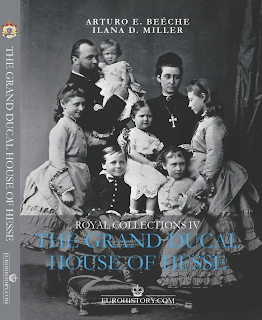Para comprar:
“Royal Collections IV. The Grand Ducal House of Hesse” (Colecciones Reales IV. La Gran Casa Ducal de Hesse), de Arturo E. Béeche e Ilana D. Miller (Eurohistory.com), 324 páginas, completamente ilustrado.
La Casa Gran Ducal de Hesse es una de las más importantes de todas las dinastías alemanas y está vinculada a casi todas las demás familias gobernantes de Europa. Tiene vínculos especialmente fuertes con la Rusia imperial y la familia real británica, lo que hace que la lectura sea muy interesante.
La historia comienza en 1567, cuando los hijos del Landgrave Felipe el Magnífico se repartieron sus vastas tierras. De esta división territorial surgieron todas las ramas de la familia Hesse. El Landgraviato de Hesse-Darmstadt se convirtió ese mismo año en un ducado independiente.
Los primeros años son una sucesión de reorganizaciones territoriales, ya que las tierras se comercializaban, intercambiaban o heredaban cuando se extinguían ramas de la familia. No fue hasta Luis IV (fallecido en 1626) que se estableció la primogenitura.
Darmstadt también estuvo en primera línea durante varias guerras. Los hijos de la familia fueron soldados y mecenas de las artes. El landgrave Ernest Ludwig construyó en la década de 1720 el Wolfsgarten, que llegó a ser muy querido por las generaciones posteriores.
En 1806, el landgrave Luis X se convirtió en el gran duque Luis I, gracias a Napoleón y a la Confederación del Rin. En esa época se construyó el Palacio Viejo.
El castillo de Heiligenberg llegó a manos de la familia en la época de Luis II. Más tarde se convirtió en escenario de muchas reuniones familiares entre las familias Hesse y Romanov. La esposa de Luis, Guillermina, tenía una segunda familia, cuyo padre se cree que fue August Senarclens de Grancy, pero que el Gran Duque reconoció oficialmente como suya. Uno de estos hijos, María, se casó con Alejandro II de Rusia; el otro, Alejandro, se unió morganáticamente con la condesa Julie von Hauke y se convirtió en el antepasado de la familia Battenberg.
Luis II fue sucedido por Luis III, que no tuvo hijos, y fue su sobrino, el futuro Luis IV, quien introdujo la conexión británica cuando en 1862 se casó con la princesa Alicia, segunda hija de la reina Victoria. Su hija Victoria se casó con el hijo de Alejandro y Julia, el príncipe Luis de Battenberg, y se convirtió en la madre de la princesa Alicia (esposa del príncipe Andrés de Grecia), la reina Luisa de Suecia, Jorge, marqués de Milford Haven, y el conde Mountbatten de Birmania. La princesa Alicia de Grecia fue la madre del duque de Edimburgo.
The family of Alice and Ludwig IV suffered tragedy after tragedy. Two daughters, Alix (wife of Nicholas II) and Ella (wife of Grand Duke Sergei Alexandrovich) met their deaths in 1918 at the hands of the Bolsheviks. Ernest Ludwig died just a month before his son George Donatus, his wife Cecile of Greece and their two sons were wiped out in an air crash in thick fog on their way to the wedding of George’s brother Ludwig and Margaret Geddes. Their third child died shortly afterwards from Meningitis. Despite all this Ludwig and Margaret (or Lu and Peg as they were known) devoted themselves to the welfare of the people of Darmstadt, becoming humanitarians and patrons of the arts. Unfortunately, their marriage remained childless and marked the end of the line. The royal turn-out for Peg’s funeral in 1997 shows how popular she was among her adopted family.
The final chapter looks at the women of the Hesse-Darmstadt family (who vastly outnumbered the males). The often-neglected female line provides the ancestors of just about every Royal family in Europe, the daughters of Landgrave Louis IX being particularly active in his respect.
The authors had the advantage of interviews with many members of the extended Hesse family, including the late Countess Mountbatten of Burma and Prince Alfred of Prussia, who provided some fascinating insights into the life of his father Prince Sigismund in Costa Rica. Prince Alfred attended a Eurohistory Conference in California in 2000 (I never forgot the sight of his queuing with the rest of us in a fast food chain).
As usual with Eurohistory, the book is packed with magnificent photos, many of them previously unpublished. They show that there was a lot of mingling between the various branches of the family, something that has often been played down more recently because of the German links The Duke of Edinburgh’s sisters all married Germans and there are some wonderful pictures of Prince Philip with his German relations, which in the U.K. we don’t often see. I found it particularly interesting to see photos of buildings in Darmstadt destroyed in the Second World War and I also spotted a rare image of a smiling Empress Alexandra Feodorovna of Russia among a group on page 135.
The text is authoritative, well researched and easy to read. This work is a “must” for all devotees of European royal history. A fascinating read, highly recommended.
By Coryne Hall
–//–
To order at EUROHISTORY:
To order at AMAZON:
The Grand Ducal House of Hesse
6300 Kensington Avenue
East Richmond Heights, CA 94805
USA
Phone: 510.236.1730
Email: books@eurohistory.com / eurohistory@comcast.net / aebeeche@mac.com




No comments:
Post a Comment